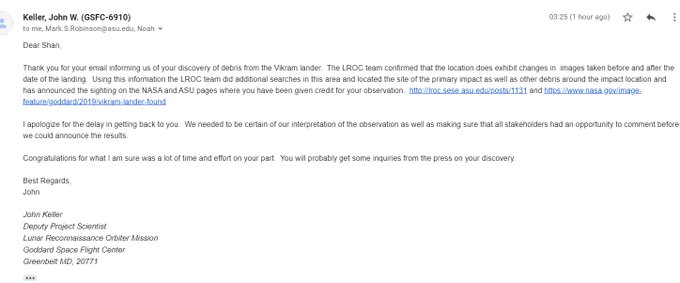Chandrayaan-2: Chennai-based Engineer Helps NASA Locate Vikram Lander
This image shows the Vikram Lander impact point and associated debris field. Green dots indicate spacecraft debris (confirmed or likely). Blue dots locate disturbed soil, likely where small bits of the spacecraft churned up the regolith. "S" indicates debris identified by Shanmuga Subramanian.
(Credits: NASA/Goddard/Arizona State University)
The US space agency NASA has finally confirmed the discovery of the debris of Chandrayaan-2’s Vikram Lander, which crash-landed on the lunar surface on September 7, 2019. The debris has been spotted about 750 meters northwest of the main crash site by an Indian engineer.
In its hunt for Vikram, NASA’s Lunar Reconnaissance Orbiter (LRO) had performed a fly-by over the designated landing site and acquired pictures of the lunar surface on September 17. The images were later released to the public by NASA on September 26.
Subsequently, many people from around the world downloaded those mosaic images to hunt for Vikram themselves, and NASA has now confirmed that one person from India succeeded in this pursuit.
Shanmuga Subramanian, a mechanical engineer based in Chennai, India, contacted the LRO project with a positive identification of Vikram’s debris. He spotted the debris as a single bright pixel on the mosaic image released by the LRO.
@NASA has credited me for finding Vikram Lander on Moon's surface#VikramLander #Chandrayaan2@timesofindia @TimesNow @NDTV
11.7K people are talking about this
After receiving Subramanian's tip, the LROC team compared the before and after images and later confirmed the identification.
As the impact point was poorly illuminated in the original image, two subsequent image sequences were acquired on October 14-15 and November 11.
The LROC team scoured the surrounding area in these new images and successfully found the impact site on the Moon (70.8810°S, 22.7840°E, 834 m elevation) and associated debris field. The November image had the best pixel scale (0.7 meters) and lighting conditions (72° incidence angle). The three largest pieces of debris are each about 2x2 pixels and cast a one-pixel shadow.
The zoomed-in version of the earlier image
(Credits: NASA/Goddard/Arizona State University)
Indian Space Research Organisation (ISRO) was set to perform a soft landing of Vikram at the southern lunar pole on September 7. However, just a few hundred meters above the lunar surface, mission control lost all communication with the Lander. After several days of internal assessments, it was revealed that the Lander failed to slow down to the required velocity, which resulted in a hard landing.
The central government only confirmed the hard landing of Vikram on November 20. However, it reiterated that it is unfair to describe the mission a failure, as most components of technology demonstration, including the launch, critical orbital manoeuvres, lander separation, de-boost and rough braking phase, were accomplished quite successfully. Moreover, all the eight state-of-the-art scientific payloads in the orbiter are performing as intended, effectively providing valuable scientific data.
"Despite the loss, getting that close to the surface was an amazing achievement," said NASA in its statement.




Comments
Post a Comment